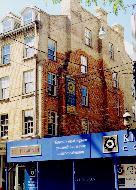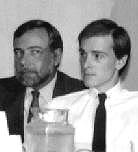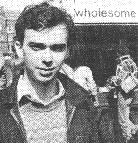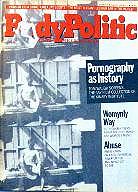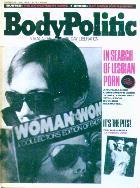|
Promiscuous |
|
Sic transit Gloria
Shadow of The Albany:
|
My glasses steam up with the sweat of a space full of movement to the sound of a disco anthem: "It's Raining Men." And it seems precisely true.
Run into Gordon Montador. "No one's written this," I yell, "this euphoric, mindless, joyous being together." Gordon groaned: "All those adjectives. You sound like Edmund White."
1983
January through September
- To Jane Rule, January 18, 1983:
I was well enough by Christmas day to go for dinner with Stephen MacDonald and John Allec. It was like going to a features meeting. Actually it was quite pleasant, but did serve to remind me that I've come to have almost no friends outside this place. By the middle of the next week I'd decided it was time to go out, to have a beer and see who's there. I hadn't been to a bar in more than two months.
I ran into people I knew -- from TBP, inevitably; smiled at one I didn't. He smiled back and I knew I was on the road to recovery. I went out three more times that week, perhaps over celebrating the fact that the fever, the sore throat, the fatigue were gone.
One of the places I went, and the one where I thought most of you, was a bar called The Albany. I think I've mentioned it before as a place that, for varied reasons, manages to avoid the aggressive / intense cruisiness that for me usually leads to tedium. Mostly it's that people dance there, dance on the dance floor and off it, moving to songs that, once they become familiar, seem like anthems of particular moods.
On Sunday afternoons and evenings The Albany is packed. I walk in and my glasses blind me, steaming up with the heat and sweat of a long flashing space full of movement to the driving sound of the latest anthem, musically predictable, lyrically silly but wonderfully titled: "It's Raining Men." At that moment it seems precisely true.
I had noted The Albany to Jane in my letter of October 1982 -- the first to her ever to mention a bar. The place had opened in 1981, another venture by Dave Davies and George Pratt, on King Street near Jarvis in a long, narrow space on the ground floor of a Georgian style block dating from 1850.
I'd mentioned its patio -- among the first bars here to have one -- with bleachers tucked along the walls of equally old buildings at the back, and a dance floor "that saved it from the terminal ennui that a few other bars seem to cultivate."
By then it wasn't the only bar where you could dance, but it was the first I knew well. Its greatest anthem, played endlessly in the summer of 1982, was Laura Branigan's "Gloria." It hadn't yet climbed the charts outside gay bars (I saw her do it on TV late that fall: a new hit, the world was told) but to us it was so familiar that people out on the patio sometimes groaned when it came on.
Maybe it seemed a call to obligation: it was, after all, an anthem. So we'd rush in and dance anyway, arms in the air at its repeating chorus: "Gloria! Gloriahh!"
But back to January 1983, and that letter to Jane:
- I run into Gordon Montador, an occasional writer for TBP and a man interested in being a novelist. "No one has ever caught this," I howl at him, waving my arms out at the room, seeing again a flashing, glowing boy / man who'd been gripped in a hug with someone when I first spotted him and who'd not stopped smiling since.
"No one's written this, this euphoric, mindless, joyous being together" -- or some such; I'd be hard pressed to remember exactly what I said. But it must have been something like that: "All those adjectives," Gordon groaned. "You sound like Edmund White."
So I wander to the edge of the dance floor and say to myself: make this make sense to Jane -- without adjectives. I can't say that the shape of the head of the man dancing in front of me is "beautiful," is "exquisite." What would that tell you? I have to note the short black hair, the almost acute angle of the crown in profile, the equally sharp definition of the face -- also smiling.
He's wearing some kind of leather harness, but all I can see of it are two straps around his sides, disappearing under the denim of a trim fitting pair of bib overalls. The straps aim up on his torso to two studded bands wrapped around the tops of his biceps. I think of how all this skin against his skin must pull and stretch, must move as he moves, must make him recall his own body as he dances.
He leaves the floor. I see him talking to one of the few women there, a naked arm over her shoulder and his face close to her ear.
Edmund White would say (has said) that the adjectives are necessary, that the writer must sometimes tell and not just show, must make his or her own state part of the telling. And my state at the moment of these observations is indeed one where I want to say "beautiful," "exquisite," "joyous," "ecstatic" -- even "mindless," forgetting oneself, losing self consciousness, losing a wariness of all these other men around you and simply being with them in a shared ecstasy.
I walk home from these places smiling, talking to myself if I've had enough to drink, and thinking that I'm incredibly privileged to be able to know these things, to have come to the age of 33 (it slipped by last week) and still to know there are things that can fill me with wonder and amazement, things that are somehow mine.
And at 33 I'm coming late to this, really. Bars could be fun -- social, happy, warming -- and I've danced and danced before in my life, though not much in the last four or five years. But never having been into drugs beyond booze and an occasional sniff of poppers, I've only begun to discover what must be basic for so many other gay men.

Doomed queens:
|
Andrew Holleran had done it as fiction, again set in New York: his 1978 Dancer From the Dance was the classic novel of the disco. Activist critics hated its stereotypes, its "doomed queens," even as they recognized its power. Writing in The Body Politic in 1979, Scott Tucker could say that Dancer "portrays a world in which Stonewall never happened" but at the same time call it "a melancholy prose poem, so finely crafted that not a page passes without heartbreaking images or melting cadences."
In time Dancer would seem an elegy -- as so much gay fiction became elegy for a lost world. But that world was not lost, no matter how tragically satisfying, even fashionable, it became to say so. It was (and is) still here, despite doomed queens, gay journalists in particular, surviving to become doomsayers.
In that letter to Jane I quoted Stephen Harvey, writing about AIDS in the Village Voice. He epitomizing the scene in a phrase: "mass euphoria in the dark." It was not, for him, something to celebrate.
- "If heartland evangelists shrieked that gays were depraved for what they do, co- ghettoites have implied we were deprived if we didn't -- that there was something stunted and incomplete in the lives of any gay men who couldn't get into these obligatory Saturday nights of mass euphoria in the dark.
"That the fun could become both boring and demoralizing if it fossilized into an unwavering routine was an unmentionable possibility. To cast doubt on any aspect of the way we habitually behave has been derided out of hand as a reactionary sop to our bigoted enemies.
"Never mind that any gay man who didn't partake in all this really had no options if he wanted to feel part of the zeitgeist at all. In this town at least, apart from one Sunday in June, what gay solidarity means is the high times you have with other regulars of the bar, disco, bathhouse of your choice."
"Before that night I thought I understood the 'passionate' in 'passionate friendship'; now it seems to me a force beyond telling."
Michael Lynch
at Stages, with the lover
of a lost friend.
The Body Politic, March 1983.
In this town the downside of ghetto glitz had been far from "unmentionable." It had been the early gay movement's stock in trade: the scene was alienating, oppressive, grim. As I said to Jane, we had long been willing "to dismiss things ('mindless' indeed) we'd never really come to know ourselves."
But now, more and more, we did know them. "Mind you," I went on, "this is all now part of the new orthodoxy of the movement, at least in Toronto: the regulars of the bars, baths and discos do constitute a kind of solidarity for most urban gay men, a kind we now say we activists were unwise to ignore."
This was one legacy of the bath raids. I assured Jane I was "not about to lose myself in the fossilized, unwavering routine of a disco queen" -- but, I must say, I liked this new orthodoxy a lot better than the old one.
And for one good reason: it was true. Part of that truth was this: the bars and discos were not really "mindless." They never had been entirely and now, I felt, we were ever more mindful of each other there.
In TBP's March issue Michael Lynch reflected on the death of that New York friend he'd told of in "Living with Kaposi's." There he had called him "Fred," the man's parents requesting the pseudonym. In this piece he was, as in life, Larry Okin. Helen and Aaron Okin had written to thank Michael for his article; in a way to come out themselves: they wrote to The Body Politic too, sending a picture of Larry and his lover Bruce Schentes. We printed it with their letter.
At the end of that March piece Michael wrote of mourning Larry, with Bruce, visiting from New York, at Stages.
- "We danced with a furious rage against our loss, brought Larry back to life between us on the dance floor, electrified our bodies with an energy that could only have been his legacy entering into us as it departed from his hardy- handsome mould. A death dance, we found, is no mild, pallidly mournful mime, but a vigorous rout, a transfer of power from the dead to the living.
"Before that night I thought I understood the 'passionate' in 'passionate friendship'; now it seems to me a force beyond telling."
It might seem an odd choice. But they were looking to a ready model of grassroots action: The Right to Privacy Committee.
On March 12 he met at The Body Politic office with, among others, Ed Jackson. The Red Cross, trying to avoid panic over "tainted blood," had called the paper, seeking advice from "the homosexual community." They had got Eddie; he had called in Michael and those others: Bill Lewis; Randy Coates; social worker David Kelley; doctors Don Briggs, Stan Read, and Jack Fowler; Robert Trow, and Alan Miller.
Robert was with both TBP and Hassle Free Clinic, a community based service seeing more gay men than any other medical facility in Canada. Alan, working with the Canadian Gay Archives, had done what was then the world's only bibliography on gay men and AIDS.
Gays in Health Care, with which some of these people were involved, planned a public forum on hepatitis B and AIDS, set for April 5. This March 12 group met again on March 22 and agreed to take to that forum a proposal to set up "an ongoing AIDS committee."
More than 300 people showed up at that forum, not only taking to heart the idea of an ongoing effort but many signing up for it right there. They met again on April 26, forming five working groups -- community education; patient support; fundraising; medical liaison; and media relations -- coordinated by a steering committee.
|
Not an "AIDS victim"
A Person With AIDS:
|
Like the RTPC, ACT was entirely run by volunteers (at first), mostly gay men but this time around more women, too, most of them lesbians. There were similar groups in Vancouver and Montreal by June. Local community groups, almost entirely gay, responded to AIDS well before anyone else, even before things here looked serious, statistically speaking: only three diagnosed cases of AIDS were reported in Toronto at the time; 32 across all of Canada.
An ad hoc AIDS task force set up by Health and Welfare Canada met for the first time in May: all its members were doctors, none gay. TBP reported: "chairman Dr Alastair Clayton told an Ottawa newspaper it would not be appropriate to include 'interest groups' in discussions of such a highly technical and scientific nature."
On June 29 an "interest group" of more than 700 people showed up at another forum in Toronto. There seemed a small chance of getting government funds for ACT, but it meant having a more formal structure. A board of directors was elected in July, Michael Lynch, Bill Lewis and Randy Coates all on it.
Some money did come: a $62,000 job creation grant. ACT would not get its first health related provincial funding, and then not without a fight, until fiscal 1984 - 85: all of $15,000. The Ontario Ministry of Community and Social Services kicked in as much: its minister was Susan Fish, whose downtown Toronto riding was heavily gay (she would later be on ACT's board). The first city and federal health money took yet another year to arrive.
ACT announced itself to the world in a press conference, July 19, 1983. With them was a 28 year old man from Ottawa, Peter Evans, the first person in Canada to say publicly that he had AIDS. Peter read a statement made by 12 "AIDS victims" who had attended a doctor dominated forum in Denver that June:
- "We condemn attempts to label us as victims, which term implies defeat, and we are only occasionally patients, which term implies passivity, helplessness and dependence upon the care of others.
"We are People with AIDS."
|
Wholesome?
Not enough:
|
There was a bit of fun in court, or rather just outside it. That genial Scotsman Sgt Thomas Stephen (well known to all of us now as Tommy), leading Kevin and a band of supporters looking for the correct courtroom, took them through the dank inner courtyard of Old City Hall. "Tommy," Kevin said, "you're taking us to the dungeon!" "Ach, no Kevin," he replied. "That doesn't happen 'til ahfter the trrrial."
But the fun stopped with Judge David Vanek, not known for a sense of humour, his reputation proved in his March 4 verdict. He barred anyone under 16 from the room, posted a guard at the door, and apologized to the court reporter for the "embarrassing" language she was about to hear. He called the two magazines under charge "lewd and disgusting," saying they included "disgusting sexual acts, sodomy in the presence of a third party" -- though no penetration was shown -- "the actual ejaculation of semen and other unspeakably filthy subjects."
Vanek spoke with horror of "the proliferation of smut," telling Kevin: "You were just a pawn in this game." The pawn got a conditional discharge with two years' probation.
Kevin's lawyer launched an appeal. Reporting that we ran a shot of Kev looking very much his age, the caption's lead: "Guilty but appealing." It had been taken at an International Women's Day event, a food vendor's cart in the background putting a word next to Kevin's head: "Wholesome."
Kevin's appeal wouldn't be heard until February 1984 and he'd win it, sort of, his conviction overturned but a new trial ordered. In the end the police never found Kevin to serve him a summons. The Crown quietly let the case drop.
|
Getting off
Collective defence
|
Baker, not lawyer
Dennis Findlay, star player of the RTPC's Courtwatch, was better known (since the late '70s & still, at his Altitude Baking on Queen St E) as a purveyor of fine sweets. He'd been among the creators of Canada's first major gay education effort, the Operation Socrates Handbook, produced by the Waterloo Universities' Gay Liberation Movement in 1973.
In the end we would win. The cops had done us a favour, making us prove -- to them, to politicians & the media & most of all to ourselves -- that we were a community: cohesive, vocal, strong.
Star performer on that team was Dennis Findlay, a baker not a lawyer. He was allowed to represent some found-ins, getting four acquitted and charges dismissed for another eight. Even one judge marvelled at what a "good job" Dennis had done "for a fellow with no legal training at all." By then lots of us felt we'd had no little legal training.
A collective defence team of 25 real lawyers had a success rate nearly matching Dennis's. Of the 450 people charged in Toronto in 1981 and in the 1977 Truxx raid in Montreal -- where collective defence was also strong -- 87 percent, so far, had got off.
Some isolated men had pleaded guilty. Of those who didn't, only one had been convicted. As Roger Spalding wrote in that piece:
- "A cool million dollars (probably more) of taxpayers' dollars and the expertise of police and Crown prosecution systems in Canada's two largest cities produced perhaps one clear conviction out of 450 arrests."
It wasn't over. Cases would drag through the courts well into 1984. At one in March of that year, where Paul Aboud was among three accused keepers cleared for lack of evidence, Judge Charles Paris asked, "Is this the last of these cases? I'm going out to buy a case of champagne to celebrate."
Even by then, it wasn't time for champagne. Not only were cases still pending, but new ones had begun. On April 20, 1983, 15 cops, led by our own Tommy Stephen, made an 11 pm visit to The Back Door Gym and Sauna, again. They arrested six men as found- ins, two as keepers, and two others as "inmates," a term so far unfamiliar to us, usually used against prostitutes.
No matter: the response we knew well enough. On April 26 I wrote Jane:
- I was at Buddy's with David Chang and Craig Patterson when the rumour of the raid (at that time raids, we thought, but there was only one) began to circulate. We rushed over, good little activists, and spent the next three hours standing around making stiff jokes with policemen.
The community response was quite encouraging: we were there in a flash monitoring the event, the RTPC was there making sure that those charged knew about legal defence and possible financial help. We spent Thursday night having a strategy meeting at the BP office, and later Ed, Kevin Orr, Francis Gillis from the RTPC and I spent the whole night preparing an insert and a flyer to inform people of a demo on Saturday.
Again, an issue of TBP had just gone to press -- but hadn't yet been distributed. We stuffed local copies with that insert and put a special sticker on the cover. Three days later, at 10 pm, there were 1,000 protesters at Yonge and Wellesley. Again.
Chief marshalls Bob Gallagher and Christine Higgins told police they'd march down Yonge to Old City Hall. They said: "You're not going anywhere." Earlier that day the police had kept more than 10,000 people protesting cruise missile testing in Canada off Yonge Street. A police cordon formed to block the route south. So Bob Gallagher told the crowd: "We're going north, to Bloor." The police rushed north too, around the crowd, and tried another cordon. It was getting rough. To be safe, the marshalls yelled, "Sit down!" So, we had yet another five minute main street sit in.
The police relented; the march made its usual way to police HQ on Jarvis Street. The Toronto Sun reported it all the next day, with the headline: "Gays confront cops -- and win."
In the end, we would win. Mostly. In September 1984, George Hislop and Peter Maloney would have all their charges dismissed on the condition that they agree not to sue for malicious prosecution. The mass of charges laid against other bath owners in the 1981 raids would be dropped in exchange for guilty pleas to one charge each. Three paid fines.
In February 1985 the owner of The Back Door would also pay a fine, all charges against others arrested there dropped. With that it was finally over, more than six years after it had all begun at the Barracks in December 1978. Defence costs had topped $150,000. But that April 20, 1983 raid on The Back Door would be the last -- for the 1980s, anyway.
The police, to their consternation, their befuddled anger not fading for years, had done us a favour. They had made us prove -- to them, to politicians and the media and most of all to ourselves -- that we were a community: strong, vocal, and cohesive. Push us, and we'd push back, hard.
|
TBP does porn (Hardly anyone notices)
Rare looks at the thing itself
|
With the Red Hot Video ad & the conflation of sex & race, a faultline ripped through the collective & beyond.
For the first time since 1978 The Body Politic could not take for granted the solid support of its community. Brave little David had, for some, become Goliath.
For The Body Politic this year, the biggest of the "Big Four" was porn. Our long defence against state attacks on our right to publish had made it more comfortable for us to go on about censorship, morally easy to oppose, than to actually look at pornography itself. For the most part we had left it to the right wing and its anti porn feminist allies to do that.
There were, however, a few significant exceptions.
Tom Waugh had done a five page piece in the January / February 1983 issue on the gay film collection of the Kinsey Institute. It included a sidebar by Alan Miller on the "beefcake" magazines of the 1940s and '50s. Together they were titled "A heritage of pornography," that heritage both celebrated and critiqued. Chris Bearchell had surveyed lesbian porn -- from fake to real, Penthouse to the dyke produced Cunt Coloring Book -- in another five page piece called "Art, trash and titillation" in this year's May issue.
These articles were among the few in TBP to look carefully at pornography, in part to rescue its definition from those who saw it as inherently immoral or violent -- or both.
Neither piece raised much stir. Something much smaller would.
In the June 1983 issue, on page 39, was an ad for Red Hot Video in Vancouver. It had no images, named no titles; it was just a quarter page and not the only sex video ad we'd run. But none of that mattered. Red Hot Video had been a target of anti porn protests in Vancouver, three of its outlets firebombed. The collective had debated running the ad for six months.
In a small note at the front of the June issue we explained: while fearing our decision might alienate "many in our community of friends -- feminists, lesbians and gay men," the final collective sense was that "the anti porn movement is bad politics, playing into the hands of right wing, moralizing elements in our society."
In the next issue there was a page and a half of letters in protest, one signed by 58 people, 24 of them once involved with TBP as writers, columnists, even as collective members.
There was another page and a half on another matter. In that same June issue we'd added a fifth hot topic to the Big Four, one long smouldering if not paid much attention in gay politics: race. Again the instigation was an ad, for a gay sex mag, WASP: White Assed Super Pricks, its contents "Unethnic" and "Unorthodox." That one we had not run.
Ken Popert, in an essay titled "Race, moustaches and sexual prejudice," said we had perhaps suppressed expression of a "legitimate sexual preference." Racially tinged desires, he said, were as deeply ingrained, inexplicable -- and hence blameless -- as being turned on by moustashes. Or, say, by men.
- "I know there are people who would say we have to struggle to overcome the racism in our desire, to remake our sexuality so that it more closely reflects our most thoughtful selves. Well, it's a noble sentiment, but what would it mean in practice? ...
"And doesn't the notion that we should modify our sexuality according to morality or politics subvert the intent of gay liberation? Gay liberation, before anything else, stands for the integrity and inviolability of sexual desire. Racism will go out of our sexuality when racism goes out of society, and not before."
Tim McCaskell responded with a rare letter of his own: "Getting racism out of society, and struggling with the complex ways that a racist society is affecting our 'personal' lives is something that no gay person can afford to ignore." Ken's "Race, moustaches and sexual prejudice" had sent a rift through the collective, a faultline that held then, but not for long. Less than two years later it would fracture beneath our feet.
That faultline had ripped well beyond our walls, over both race and Red Hot Video. For the first time since 1978, when people reluctant at first had rallied to the paper after the "Men loving boys" raid, The Body Politic could no longer take for granted the solid support of its community.
Brave little David had, for some, become Goliath.
|
TBP's Trials: Act One, Scene Four (denouement): Out of court at last. |
Nearly six years and $100,000 in legal costs after that case had begun, it was finally over. We had won. The cover of the first issue after the Crown let its deadline lapse could safely say beside the logo: "Out of court at last!"
A good thing, too: by then, we might not have had as much supportive company there. Years later, Sue Golding would tell me she'd seen the summer of 1983 as the beginning of the end of The Body Politic.
As it would turn out, she was right.
Go on to 1983: October through December
Go back to: Contents page / My Home Page
This page: http://www.rbebout.com/bar/1983a.htm
December 1999 / Last revised: June 18, 2003
Rick Bébout © 1999-2003 / rick@rbebout.com
